Gresley’s Silver Link continues Tim Hillier-Graves’ studies of the London and North Eastern Railway’s Chief Mechanical Engineers, following his previous studies of Arthur Peppercorn and Sir Nigel Gresley’s successor, Edward Thompson.
Published in November 2022 by Pen and Sword as part of its “Locomotive Profiles” series and written by Tim-Hillier Graves and Ronald Hillier, this hardback book measures around 254 mm x 248 mm, and has 224 pages, 35 colour and 420 black-and-white illustrations.
It has a published price of £35.00 but Pen and Sword has it available online for £24.50 and it can be purchased from Amazon for £24.61.
Although the book is credited as being written by Tim-Hillier Graves and Ronald Hillier, in reality, Tim-Hillier Graves has finished a story that was compiled by his uncle, Ronald Hillier, who died forty years before this book was written. The author’s gratitude to Hillier extends to an appreciation at the beginning of the book.
Unlike other books in Pen and Sword‘s “Locomotive Profiles” series, this book focuses as much on the stories and context of the interwar era of railway development as on the technical details and specifications of the A4 Pacifics, though there are still plenty of those included in the form of tables and charts.
Of interest is how Gresley’s designs were influenced by the Art Deco period and how he was conscious of what was happening in other parts of the world, in particular France, America, and Germany. They were each linked by their quest to combine style with speed, and there are stories of Gresley’s visit to each country as well as research carried out by the National Physical Laboratory in Teddington into the effects of streamlining.
With seven chapters, the book is as much a description of the development of railway locomotives in the inter-war years as it is of the A4s. Chapter 1 is titled “1935 – The Modern World Takes Shape”, which seems the perfect accompaniment to the Art Deco architecture on the left below. Throughout the 1930s, the search for speed that began in the 1920s continued, led by Gresley’s Flying Scotsman.
Speed is also the theme of the right-hand photos, with at the top right Sir Malcolm Campbell’s Blue Bird IV racing car which had just achieved the World Land Speed Record of 246 mph, and at the bottom right are the two great men of speed, with Campbell shaking the hand of Flying Scotsman’s driver with Nigel Gresley looking on.
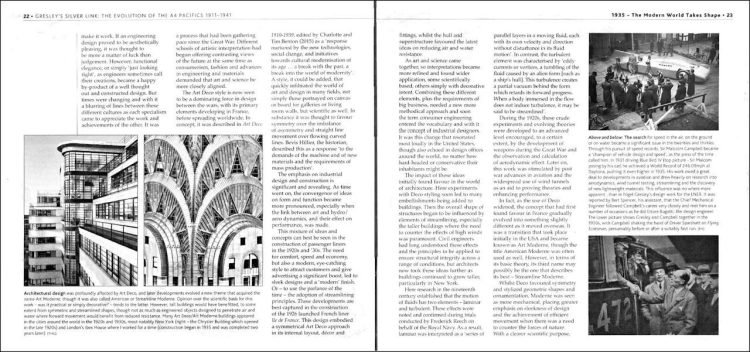
Chapter 2 “The Railways Respond To A Rapidly Changing World” describes how, on both sides of the Atlantic, electrification and streamlining were increasingly being seen as the way forward, and were having an influence on Gresley’s thinking.
In France, Etorre Bugatti used his experience with motor car construction to produce the streamlined unit seen at the top left below. The other two photos on the left-hand page show the USA’s Pennsylvania Railroad’s attempt at streamlined diesel units and at the top right is one of its streamlined electric trains, At the same time, the New York Central decided the way forward was a streamlined steam locomotive, as shown at the bottom right.
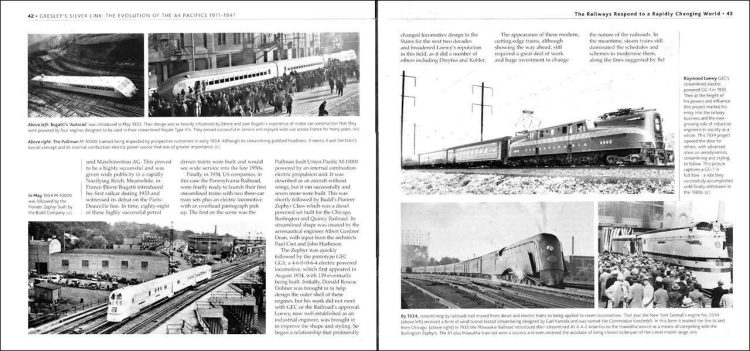
The most interesting part of the book is Chapter 3 “Gresley Considers The Future”, which describes his insights into the need to develop a more-powerful locomotive fleet and the many experiments he carried out. He also studied designs from elsewhere, especially the USA where he was influenced by the Pennsylvania Railroad’s K4 Pacifics in both their non-streamlined and streamlined forms, as seen at the top right below.
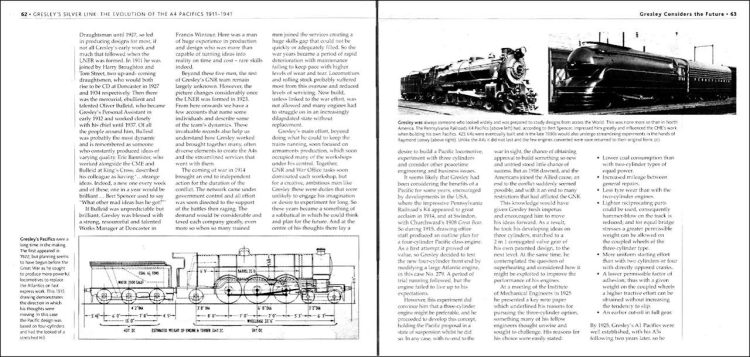
Many would argue that the culmination of Gresley’s career was his introduction of Pacific locomotives. Chapter 4 “The Big Engines Arrive” provides a fascinating account of how comparative tests were carried out both between members of the same class and between two of the Great Western Railway’s Castle Class locomotives.
The chapter also describes Gresley’s particularly novel design for a locomotive tender that incorporated a corridor that allowed crews to be changed whilst the train was travelling at high speed so that the train could travel non-stop between King’s Cross and Edinburgh without the need to stop en route for a change of crew.
An example of a corridor tender is shown at the top left below. The other photos below are all of the inaugural run of the Flying Scotsman train from London to Edinburgh, while at the bottom right is one of a series of publicity images where a contest was held to see whether the train or plane was faster between the English and Scottish capitals.
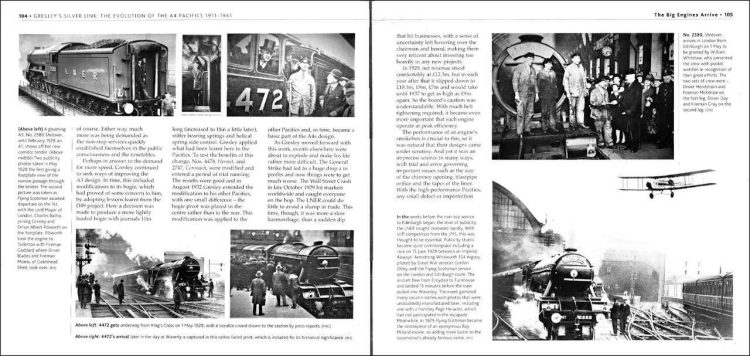
The book includes a 16-page colour section that highlights how the quest for speed and luxury was at the forefront of advertising in the 1930s, and which Gresley could not have failed to have been influenced by. The photos below quite clearly support his quest.
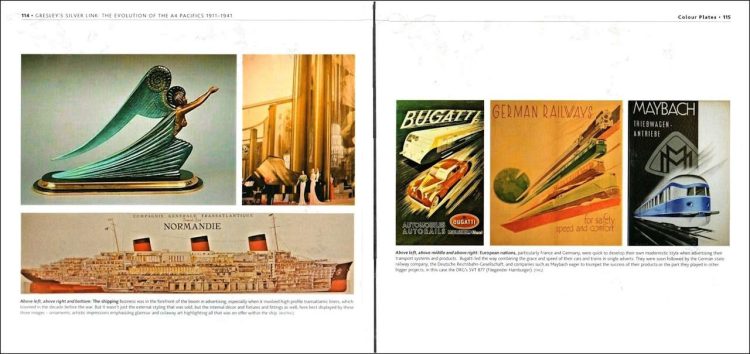
Chapter 5 “Gresley’s Golden Thread Revealed” continues the story of his seemingly Midas touch for producing the perfect locomotive, including a visit to Germany to study the Maybach designs for streamlined railcars and the extensive investigations and experiments into the effect of wind resistance, culminating in his A4 design and the special carriages for the Coronation express train. The photos on the pages below illustrate various stages in constructing the A4s.
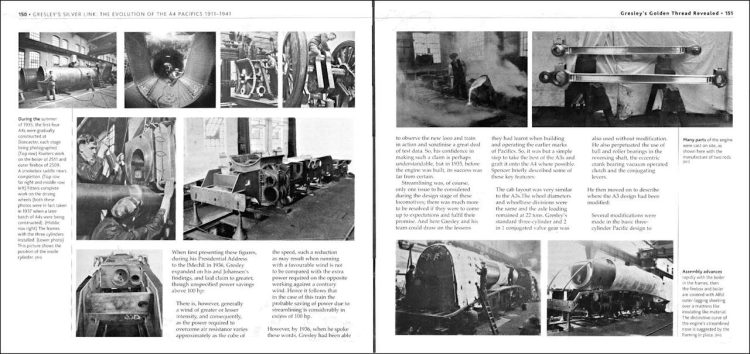
At the same time as the A4s were being built, extensive trials were being held in Germany to develop their own streamlined steam locomotives. Chapter 6 “Test Evaluate And Complete” describes the interaction between Gresley and the Germans and his continuing development of the A4s.
Sir Nigel Gresley will always be associated with Mallard and its World Record for steam train haulage, and there is extensive coverage of the events leading up to the record in Chapter 7 ”To Everlasting Glory”. The chapter also describes Gresley’s development of streamlined B17 Class 4-6-0s for use on the Liverpool Street to Norwich route.
Unlike other books in Pen and Sword’s “Locomotive Profiles” series, Gresley’s Silver Link focuses as much on the stories and context of railway development in the interwar years as on the technical details and specifications of the locomotives, though there are still plenty of those included in the form of tables and charts.
The author draws on the rich collection of notes and photographs and interviews with former crew members that his uncle, Ronald Hillier, amassed over his lifetime as a passionate railway enthusiast, to provide a vivid and detailed portrait of Silver Link and its A4 classmates.
The book offers a fascinating glimpse into the history and culture of railways in Britain and abroad during a time when speed and glamour were paramount. Of interest is how Gresley’s designs were influenced by the Art Deco period and his knowledge of what was happening in other parts of the world, in particular France, America, and Germany.
They were each linked by their quest to combine style with speed, and stories of Gresley’s visit to each country is fascinating, as well as research into the effects of streamlining carried out at the National Physical Laboratory in Teddington. There is a wealth of archival sources, photographs and interviews with former crew members to provide a vivid and detailed portrait of these iconic machines.
Although the title of the book gives the impression that it is solely about the A4 Pacifics, it also describes the background behind the design and construction of the new style of carriages introduced for the ‘Silver Jubilee’, the ‘Coronation’ and the ‘West Riding Ltd’.
With a narrative that avoids endless technical facts, the book is a very enjoyable read and is highly recommended.
The book is available to purchase from Amazon and Pen and Sword.
RailAdvent would like to thank Pen and Sword for providing it with a copy of the book for review.





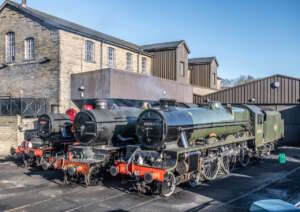
Responses